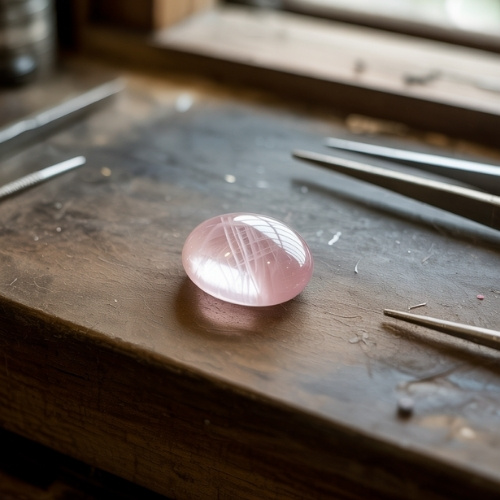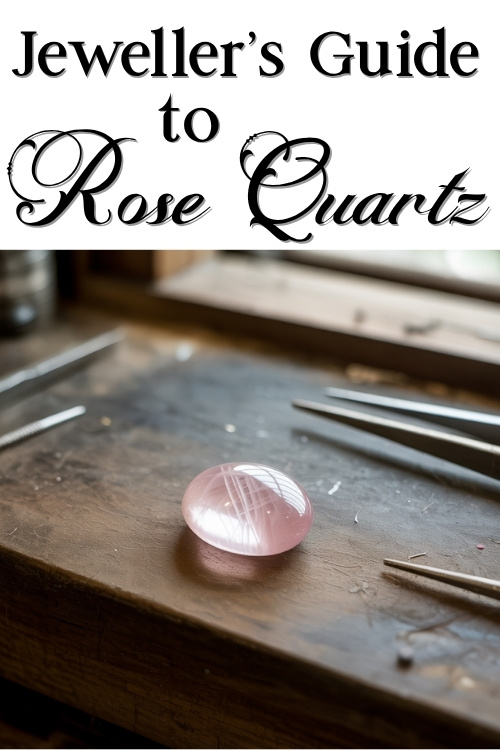There’s a softness to rose quartz that draws the eye and soothes the spirit. With its gentle pink hue and cloud-like textures, this beloved member of the quartz family brings both visual charm and emotional symbolism to jewellery design. Romantic yet grounded, rose quartz has long been a favourite for meaningful pieces, and its abundance makes it as practical as it is poetic.
Whether you’re sourcing smooth cabochons, faceted gems, or sculpted forms, this stone offers remarkable versatility for jewellers working across styles, and price points.
Basic Identification Information
Name & Synonyms:
Rose quartz
Species:
Quartz
Colour Range:
Pale to medium pink
Refractive Index:
1.544 – 1.553
Birefringence:
0.009
Optical Sign:
Uniaxial +
Pleochroism:
Weak to strong intensity of 2 colours
Different shades of pink
Specific Gravity:
2.650 – 2.655
Fluorescence:
Usually inert but can occasionally show a weak purple under UV light
Lustre:
Vitreous (glass-like)
Clarity:
Rose quartz doesn’t have a clarity type as it’s usually translucent to opaque. It often has eye-visible cloud-like inclusions or fine rutile fibres that create a soft, velvety appearance. High-clarity material is rare and usually faceted for collectors or fine jewellery.
Gems Often Mistaken For:
Morganite, pink opal, pink chalcedony
Mohs Hardness:
7
Wearability:
Good
Birthstone:
Not a traditional or modern birthstone, but sometimes its used as a cheaper alternative for October.
Spotting Synthetic (Lab-Grown) Rose Quartz
Lab-grown rose quartz is rare but not impossible to encounter. When it does appear, it may be too perfect, with unusually uniform colour and clarity. Under magnification, synthetic pieces often lack the natural zoning or cloud patterns of untreated rose quartz.
Common Treatments
Most rose quartz available today is untreated, which adds to its charm for jewellers prioritising natural materials and ethical sourcing.
That said, some lower-grade or darker pink specimens, particularly beads or carved items, may be dyed to intensify their hue. This is more common in mass-produced or decorative pieces rather than fine jewellery material.
Heat treatment is rare, but when used, it aims to gently improve the stone’s transparency or reduce the appearance of internal cloudiness. The effects are usually subtle and not easily detected.
Durability & Setting Considerations
With a Mohs hardness of 7 and no cleavage, rose quartz is structurally sound for most jewellery pieces.
That said, it’s still a member of the quartz family, so while it resists scratching better than softer stones, it isn’t immune to surface wear, especially in daily-wear rings or bracelets.
The stone’s inclusions, particularly rutile or dense veils, may slightly reduce toughness, so avoid high-pressure or tension settings on heavily included gems.
Care should also be taken during polishing or repair work to avoid thermal shock, and don’t expose the gem to harsh chemicals.
Care Instructions
Cleaning:
Use warm water, mild soap, and a soft brush. Avoid ultrasonic and steam cleaners to prevent the stone from being damaged.
Storage:
Store separately from harder gemstones like sapphire or spinel to avoid scratching. A soft pouch or individual compartment is ideal.
Daily Wear:
Safe for everyday wear with basic precautions, such as removing rings and bracelets during manual work, like gardening.
Market & Ethical Notes
Rose quartz is abundant and accessible, with primary sources in Brazil, Madagascar, South Africa, India, and the USA. Its availability in large sizes and sculptural forms makes it a popular choice for statement jewellery and spiritual accessories.
Most material is untreated and cut near its origin, keeping environmental and social impacts relatively low. For jewellers focused on ethical sourcing, rose quartz offers an affordable entry point into mindful designing.
Symbolic & Spiritual Meanings
Often called the “stone of unconditional love,” rose quartz is closely linked to the heart chakra. It’s said to soothe emotional wounds, open the wearer to compassion, and encourage forgiveness and self-acceptance.
Its soft energy makes it a favourite in talismans, meditation jewellery, and sentimental pieces designed to support healing and connection.
🔗 Dive deeper into Rose Quartz’s Symbolic & Spiritual Meanings
Etymology
The name “rose quartz” is a direct nod to its delicate blush colour, with “rose” referencing the flower-like pink hue. The word “quartz” is thought to derive from the German term quarz, which became widely used in mineralogical texts during the 16th century.
🔗Curious about how Rose Quartz was viewed in ancient cultures? Explore its fascinating myths and legends (coming soon)
📌 Save this jeweller’s guide to rose quartz for quick reference next time you’re working with this stunning gem.


